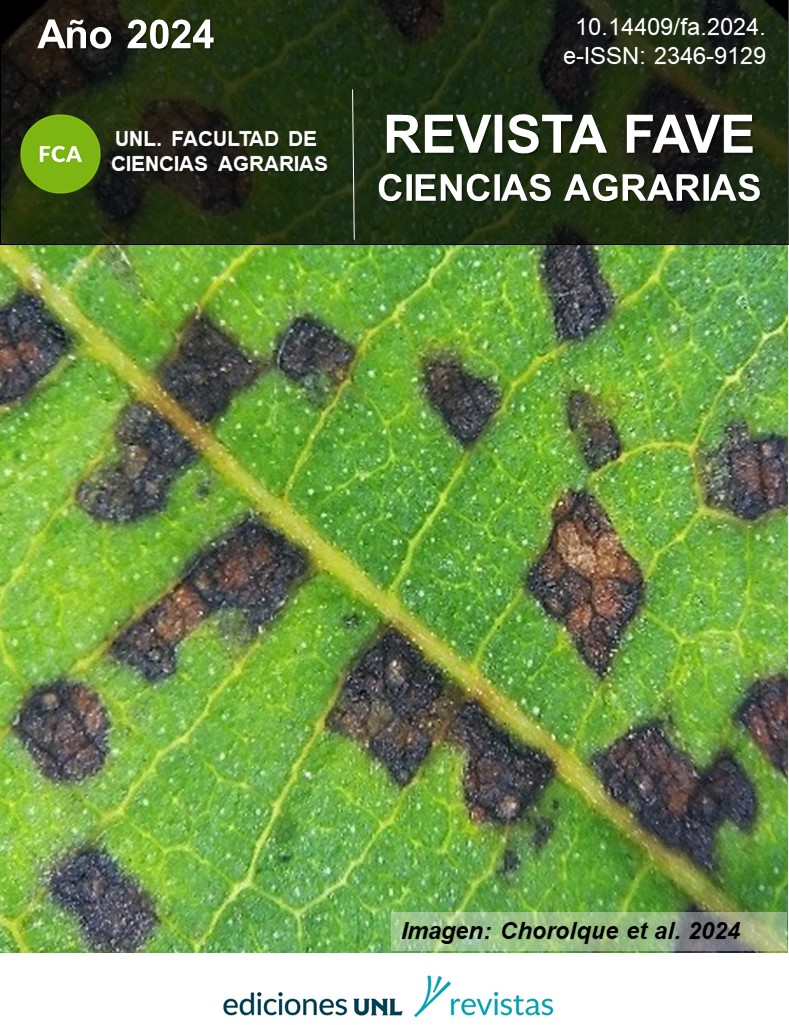Assessment of the genetic structure of two different tomato breeding populations by Principal Component Analysis
DOI:
https://doi.org/10.14409/fa.2024.23.e0024Palavras-chave:
calidad del fruto, Genética Cuantitativa Clásica, Recursos Fitogenéticos, Técnicas Estadísticas MultivariadasResumo
No Melhoramento de Plantas, diferentes populações são geradas e frequentemente representam diferentes arranjos de genes de um pool genético comum selecionado. A técnica de Análise de Componentes Principais (PCA) tem sido amplamente aplicada para avaliar a estrutura genética de diferentes populações. O objetivo desta pesquisa foi avaliar o PCA para avaliar a estrutura genética de duas populações de tomate reprodutores, uma representando a etapa final de um programa de melhoramento (população RIL) e a outra, uma etapa inicial (uma população de seis gerações básicas, composta por dois genitores homozigotos, seu F1 heterozigoto e o F2 segregante e dois retrocruzamentos). Ambas as populações foram avaliadas quanto a características quantitativas fenotípicas e a estrutura da população foi avaliada em termos de variâncias e covariâncias. O PCA foi adequado para avaliar as diferenças na estrutura genética para as características de qualidade dos frutos avaliadas em ambas as populações.
Referências
Acquaah, G. (2015). Conventional Plant Breeding Principles and Techniques. In: J,.Al-Khayri, S. Jain and D. Johnson, (eds.). Advances in Plant Breeding Strategies: Breeding, Biotechnology and Molecular Tools (pp 115-158). Springer, Cham. https://doi.org/10.1007/978-3-319-22521-0_5.
Aditya, J.P.; Bhartiya, P.; Bhartiya, A. (2011). Genetic variability, heritability and character association for yield and component characters in soybean (G. max (L.) Merrill). Journal of Central European Agriculture 12, 27-34. https://doi.org/10.5513/JCEA01/12.1.877.
Cabodevila, V.G.; Cambiaso, V.; Rodríguez, G.R.; Picardi, L.A.; Pratta, G.R.; Capel, C.; Lozano, R.; Capel, J. (2021). A segregating F2 population from a tomato second cycle hybrid allows the identification of novel QTL for fruit quality traits. Euphytica 217, 453-461. https://doi.org/10.1007/s10681-020-02731-6.
Del Medico, A.P.; Cabodevila, V.G.; Vitelleschi, M.S.; Pratta, G.R. (2019). Multivariate estímate of heritability for quality traits in tomato by the multiple factor analysis. Pesquisa Agropecuária Brasileira 54. https://doi.org/10.1590/ S1678-3921.pab2019.v54.00064.
Del Medico, A.P.; Cabodevila, V.G.; Vitelleschi, M.S.; Pratta, G.R. (2020). Characterization of tomato (Solanum lycopersicum L.) generations according to three-way data analysis. Bragantia 79, 8-18. https://doi.org/10.1590/1678-4499.20190047.
Dempewolf, H.; Baute, G.; Anderson, J.; Kilian, B.; Smith, C.; Guarino, L. (2017). Past and future use of wild relatives in Crop Breeding. Crop Science 57, 1070-1082. https://doi.org/10.2135/cropsci2016.10.0885.
Food and Agriculture Organization – Statistics [FAOSTAT]. (2017). Production - Crops - Area harvested / Production quantity - Tomatoes - 2014. Available at www.fao.org/faostat/en. [Accessed July 21, 2021].
Gerszberg, A.; Hnatuszko-Konka, K.; Kowalczyk, T.; Kononowicz, A.K. (2015). Tomato (Solanum lycopersicum L.) in the service of biotechnology. Plant Cell Tissue and Organ Culture 120, 881–902. https://doi.org/10.1007/s11240-014-0664-4.
Iqbal, Z. ; Hu, D. ; Nazeer, W. ; Ge, H. ; Nazir, T. ; Fiaz, S.; Gul, A.; Shahid Iqbal, M.; El-Sabrout, A.M.; Maryum, Z.; Pan, Z.; Du, X. (2022). Phenotypic correlation analysis in F2 segregating populations of Gossypium hirsutum and Gossypium arboreum for boll-telated traits. Agronomy 12, 330. https://doi.org/10.3390/agronomy12020330.
James, G.; Witten, D.; Hastie, T.; Tibshirani, R. (2021). An Introduction to Statistical Learning With Applications in R. Springer, New York, NY. USA.
Kearsey, M.J.; Pooni, H.S. (1996). The Genetical Analysis of Quantitative Traits. Chapman and Hall, London, UK.
Lu, D.; Xu, S. (2013). Principal component analysis reveals the 1000 Genomes Project does not sufficiently cover the human genetic diversity in Asia. Frontiers in Genetics, Section Applied Genetic Epidemiology 4. https://doi.org/10.3389/fgene.2013.00127.
Mahuad, S.L.; Pratta, G.R.; Rodriguez, G.R.; Zorzoli, R. and Picardi, L.A. (2013). Preservation of Solanum pimpinellifolium genomic fragments in recombinant genotypes increased tomato fruit quality. Journal of Genetics 92, 195-203.
McVean, G. (2010). A genealogical interpretation of Principal Components Analysis. PLoS Genetics 5. e1000686. doi: 10.1371/journal.pgen.1000686.
Nachimuthu, V.V.; Robin, S.; Sudhakar, D.; Raveendran, M.; Rajeswari, S.; Manonman, S. (2014). Evaluation of rice genetic diversity and variability in a population panel by Principal Component Analysis. Indian Journal of Science and Technology 7, 1555–1562. 10.17485/ijst/2014/v7i10.14.
Pereira da Costa, J.H.; Rodríguez, G.R.; Pratta, G.R.; Picardi, L.A.; Zorzoli, R. (2014). Pericarp polypeptides and SRAP markers associated with fruit quality traits in an interespecific tomato backcross. Genetics and Molecular Research 13, 2539-2547. https://doi.org/10.4238/2014.January.24.10.
Pratta, G.; Zorzoli, R.; Picardi, L.A. (2000). Multivariate analysis as a tool for measuring the stability of morphometric traits in Lycopersicon plants from in vitro. Genetics and Molecular Biology 23, 470-483. https://doi.org/10.1590/S1415-47572000000200039.
Pratta, N.N.; Quaglino, M.; Rodríguez, G.R.; Zorzoli, R.; Pratta, G.R. (2010). A multivariate approach to the Proteomics of tomato fruit ripening. Genes, Genomes and Genomics 4, 48-51.
Pratta, G.R.; Rodriguez, G.R.; Zorzoli, R.; Valle, E.M.; Picardi, L.A. (2011a). Molecular markers detect stable genomic regions underlying tomato fruit shelf life and weight. Crop Breeding and Applied Biotechnology 11, 157-164. https://doi.org/10.1590/S1984-70332011000200008.
Pratta, G.R.; Rodriguez, G.R.; Zorzoli, R.; Valle, E.M.; Picardi, L.A. (2011b). Phenotypic and molecular characterization of selected tomato recombinant inbred lines derived from a cross Solanum lycopersicum x S. pimpinellifolium. Journal of Genetics 90, 229-237. https://doi.org/10.1007/s12041-011-0063-0.
Pressoir, G.; Berthaud, J. (2004). Population structure and strong divergent selection shape phenotypic diversification in maize landraces. Heredity 92, 95–101. https://doi.org/10.1038/sj.hdy.6800388.
Rodriguez, G.R.; Pratta, G.R.; Zorzoli, R.; Picardi, L.A. (2006). Recombinant lines obtained from an interspecific cross among Lycopersicon species selected by fruit weight and fruit shelf life. Journal of the American Society for Horticultural Science 131, 651-656. https://doi.org/10.21273/JASHS.131.5.
Scariolo, F.; Palumbo, F.; Barcaccia, G. (2022). Molecular characterization and genetic structure evaluation of breeding populations of fennel (Foeniculum vulgare Mill.). Agronomy 12, 542; https://doi.org/10.3390/agronomy12030542.
Thormann, I.; Reeves, P.; Thumm, S.; Reilley, A.; Engels, J.; Biradar, C.; Lohwasser, U.; Borner, A.; Pillen, K.; Richards, C.M. (2018). Changes in barley (Hordeum vulgare L. subsp. vulgare) genetic diversity and structure in Jordan over a period of 31 years. Plant Genetic Resources: Characterization and Utilization 16, 112-126. doi:10.1017/S1479262117000028.
Publicado
Como Citar
Edição
Seção
Licença
Copyright (c) 2024 FAVE Sección Ciencias Agrarias

Este trabalho está licenciado sob uma licença Creative Commons Attribution-NonCommercial-ShareAlike 4.0 International License.

















